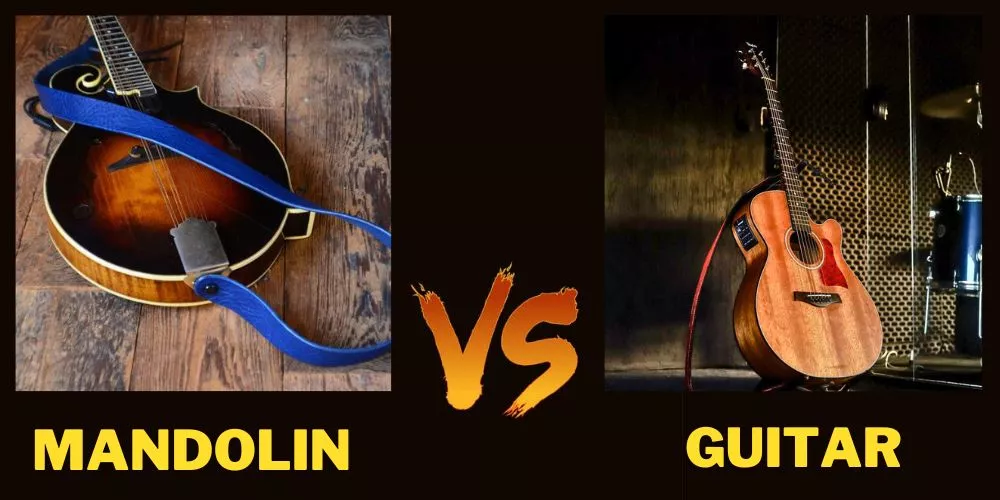The age-old question lingers, like an unresolved chord hanging in a smoke-filled jazz club: mandolin vs guitar?
It’s not about declaring one instrument superior over the other: it’s about journeying into the hearts of these beautiful instruments, discovering unique facets that bring out the music in us.
Whether you’re a musician choosing your next instrument or an avid music enthusiast seeking to deepen your understanding, this article will play a harmonious symphony of knowledge.

Contents
🎶Mandolin vs Guitar: Detailed Comparison
The precursor of the modern mandolin, the mandola, came to life in Italy around the 17th and 18th centuries.
Evolving from the lute family in the Baroque period, the mandolin’s sweet and bright sounds gained favor rapidly, most prominently in Naples, known as the birthplace of the modern mandolin.
In the early 20th century, the mandolin had its golden age in the United States. Mandolin orchestras sprang up everywhere, from social clubs to schools.
Post this period, the mandolin’s popularity gently wafted into various genres, prominently bluegrass, folk, and Celtic music.

The guitar’s roots are lost in time, with stringed instruments dating back to ancient civilizations. The modern classical guitar shape solidified in 19th-century Spain, replacing the more traditional five-string design with a six-string configuration.
In the early 20th century, with the advent of jazz and blues, the guitar asserted itself as an indispensable musical device.
The invention of the electric guitar in the 1930s opened a new horizon, propelling the guitar to a central role in nearly every genre of music worldwide.
Now let’s discuss mandolin vs guitar in a detailed manner.
Construction and Design
The mandolin and the guitar share a kindred spirit but are designed with distinct elements, giving them unique personalities.
- Mandolin: A traditional mandolin is a small, pear-shaped instrument made primarily of wood, usually spruce for the top and various wood for the back and sides, such as maple or rosewood. It has a fretted neck and a headstock at the top where eight strings are attached (four pairs of doubled strings), tuned in unison to G, D, A, E.
- Guitar: On the other hand, a guitar with an hourglass shape is larger. A typical acoustic guitar has a hollow wooden body with a sound hole in the center, a neck with frets, and a six-string headstock. The most common types of wood used in guitars are spruce, cedar, or mahogany. Each offers a broad range of tones, from bright and chiming to darker and warmer tones.
The Influence of Design on Sound and Playability: The design differences between the mandolin and the guitar drastically affect their sound and playability.
The mandolin’s small body and doubled strings produce a bright, sharp, and resonant tone. The doubled strings also create a natural chorus effect, an affinity with fast, staccato playing, the heart of bluegrass and folk music.
The guitar’s broader body and six singular strings generate a wide range of frequencies and a louder sound than the mandolin.
The large rounded body delivers deep bass frequencies, and the widely spaced strings can accommodate complex chords, ideal for various genres from pop to classical music.
Types and Nuances: Just like a human family, the mandolin and guitar families have several members, each possessing unique traits.
The mandolin family includes variations like the ‘mandola,’ ‘octave mandolin,’ and ‘mandocello,’ each differing mainly in size and tuning.
For example, the ‘mandola’ is tuned a fifth lower than the standard mandolin, while the ‘mandocello’ mirrors the cello’s tuning.
The guitar family comprises classical, acoustic, and electric guitars, each serving different musical contexts. The classical guitar, often made of nylon strings, sweeter and mellower, is perfect for classical and Flamenco music.
The acoustic guitar flaunts steel strings, a folk, pop, and country music staple. The electric guitar, the child of the electronic age, has magnetic pickups that convert string vibrations into electrical signals, tailored for rock, jazz, and blues.
The mandolin and guitar offer a world of musical possibilities within their diversity.
Playing Techniques
The playing styles of the mandolin and the guitar, while sharing several commonalities, also have unique aspects that cater their sounds to different musical settings.
The mandolin is primarily played with a pick. Picking techniques include downstroke picking, alternate picking, and tremolo picking.
The alternate picking technique is especially crucial as mandolin players often perform fast runs and solos, requiring intense alternate picking skills.

Strumming is also common, often used in rhythmic accompaniment patterns. Chording on the mandolin can be challenging due to the strings’ proximity, but it lends a vibrant, shimmering quality to chords unique to the instrument.
The guitar is played with a pick, fingers, or sometimes a combination of both. Various picking techniques include alternate picking, sweep picking, and economy picking.
The fingerstyle technique, often used in folk and classical guitar, gives the player rich control over the melody and harmony.
Strumming patterns are also extremely diverse, depending on the rhythm and genre of the music. Thanks to the broader neck and spacing between the strings, a vibrant array of chords can be produced, permitting complex voicings and harmonic progressions.
Sound Creations: A Universe of Tones: The techniques used on each instrument significantly impact the sound produced.
The mandolin’s bright, bell-like tones result from its double string configuration and the use of a plectrum. The tremolo technique, rapidly picking one or more strings, creates a sustained, shimmering sound, a signature mandolin effect.
The guitar, on the other hand, has a wide tonal capacity. A pick can produce bright, articulate tones, while finger-picking can create softer, more intricate textures.
The diverse range of strumming techniques adds rhythmic and tonal color to the instrument’s sound.
Cross-adaptation: A Melodic Bridge: Several techniques from one instrument could be used or adapted to the other.
For instance, the alternate picking technique on the mandolin can be applied to the guitar, which is particularly useful for fast melodies and solos. Similarly, the finger-picking technique, common on the guitar, can be adapted to the mandolin, especially in a quieter, more intimate musical setting.
Overall, the playing techniques contribute to the unique identities of the mandolin and guitar, shaping each instrument’s charismatic voice and distinct versatility.
Musical Styles and Genres
Due to its characteristic bright and resonant tones, the mandolin has found its niche in various music genres.
- Classical: One of the earliest genres where the mandolin took center stage. Composers like Beethoven and Vivaldi wrote music specifically for the instrument.
- Folk music: The mandolin is common in various traditional music worldwide. From European (especially Italian and Irish) folk music to American old-time music, its bright tones perfectly foster these genres’ communal and rhythmic nature.
- Bluegrass: Mandolin maestro Bill Monroe, known as the “Father of Bluegrass,” solidified the mandolin’s role in this genre. Its sharp, percussive chops and ability to carry ripping solos made it a pillar of Bluegrass ensembles.
- Italian Music: The mandolin is significant in Italian music, especially Neapolitan songs, drawing a scenic picture of Italy’s cultural landscape.

As one of the most widely used instruments, the guitar has indelibly stamped its mark on nearly every music genre.
- Classical: Most notably, the Spanish romantic and 20th-century repertoire features the soft-sounding nylon string guitar.
- Rock: From Chuck Berry’s electrifying performances to Jimi Hendrix’s trailblazing techniques, the electric guitar is the lifeblood of Rock n’ Roll.
- Jazz: Offering a wide harmonic palette, the guitar, especially hollow-body electric types, has been widely used in jazz since the early 20th century.
- Country: Acoustic guitars constantly remain in country music, often providing a rhythmical backdrop or twangy, sentiment-filled solos.
- Pop Music: A versatile instrument, the guitar is a staple in pop music, often employed in rhythm accompaniment.
A Symphony of Strings: Mandolin and Guitar Together: The mandolin and guitar, when paired together, can create intricate and diverse soundscapes across various musical settings.
- Bluegrass and Folk: The guitar often provided a rhythmic and harmonic foundation upon which the mandolin could perform melodic leads, quicker decorations, or percussive rhythmic fills.
- Classical Ensemble: A more formal setting might see the guitar taking on the role of the continuo, laying down the harmonic framework, while the mandolin provides melodic interpretations.
- Pop and Rock: Modern pop and rock outfits might use the mandolin for its unique timbre, layering it on top of the guitar to give an extra dimension of sound.
In the end, while being distinctive in their own right, both instruments can beautifully complement and enrich each other, resulting in a wide range of expressive and sonorous possibilities.
Pros and Cons
Musical Contexts, Suitability and Preferences: In a classical or orchestral setting, the mandolin might be preferred due to its historical significance in such music. Symphonies such as those by Beethoven and Mahler have parts written for the mandolin.
In genres like rock, pop, or blues, the guitar would generally be the instrument of choice due to its wider range, greater volume, and ability to play complex chord progressions.
For bluegrass or folk musicians, the choice between mandolin and guitar could be a personal preference, as both instruments are central to these styles.

The mandolin could be the better choice for a beginner interested in stringed instruments; its small size and fewer strings make it less intimidating. On the other hand, the vast learning resources available for the guitar make it a tempting choice for novices.
In the end, both mandolin and guitar are versatile and expressive instruments. The decision should ultimately determine which instrument aligns best with personal musical interests and preferences.
The Mandolin: Compact, Unique, Versatile
Advantages
✅ Portability: The small mandolin makes it portable – perfect for travel, jam sessions, and gigs.
✅ Unique Sound: Its bright, chiming tone and the natural chorus effect from the double-string configuration lend a distinctive sound to any music ensemble.
✅ Versatility: It’s a versatile instrument, fitting into numerous genres – from folk and bluegrass to classical and rock.
Drawbacks
❌ Limited Lower Range: Due to its small size, the mandolin does not possess a rich lower range like the guitar.
❌ Chord Difficulty: The tight string spacing can make complex chording difficult, especially for beginners.
The Guitar: Wide-Range, Diverse, Popular
Advantages
✅ Broad Range: A larger instrument, the guitar covers a wide frequency range, allowing for a rich diversity of tones from deep bass to high trebles.
✅ Versatile Sound: From hard-rocking electric tones to soft, mellow, acoustic sounds, the guitar’s sound is as versatile as its looks.
✅ Popularity: As one of the most popular instruments, there is a vast array of resources (books, online tutorials, etc.), making it easier for beginners to learn.
Drawbacks
❌ Physical Size: The large size of a guitar can be challenging for some, especially children or people with smaller frames.
❌ Learning Curve: While the basics can be easy to pick up, mastering advanced techniques on the guitar can be challenging and might require substantial practice.
🎶Frequently Asked Questions (FAQs)
The difficulty of learning the guitar or the mandolin largely depends on the individual learner’s musical background and aptitude. However, guitars often have a more intuitive layout and more resources available for guitar learning which may make it a bit easier for beginners than the mandolin.
Yes, a guitarist can learn to play the mandolin. The finger placements and picking patterns are different, but the theories of chords and scales are transferable. It would require some dedicated practice to adapt to the mandolin’s different techniques and smaller size.
Learning the mandolin after having experience with the guitar can be easier. Because the fret width on a mandolin is narrower, so adjusting might take some practice. However, the concepts of chords and music theory are the same, so guitarists can usually transition to a mandolin with deliberate practice.
Mandolin strings are generally of higher tension than guitar strings, making them feel harder to the touch. Thus, they could initially cause more discomfort to the fingertips than guitar strings. However, with regular practice, the fingers develop calluses, which becomes less of an issue over time.
Conclusion:
In the final analysis, both the mandolin and guitar offer unique elements in their sound, playing techniques, and cultural histories.
Neither instrument is inherently better or harder than the other; it mainly comes down to subjective preferences and the dedicated effort to learn and master either of them.
The guitar may seem more beginner-friendly due to abundant learning materials and ubiquitous presence in popular music.
However, transitioning from guitar to mandolin can prove a rewarding exploration, leveraging shared music theory while introducing new techniques.
Whether choosing between mandolin vs guitar or learning both, the journey of learning a musical instrument is always richly rewarding.
